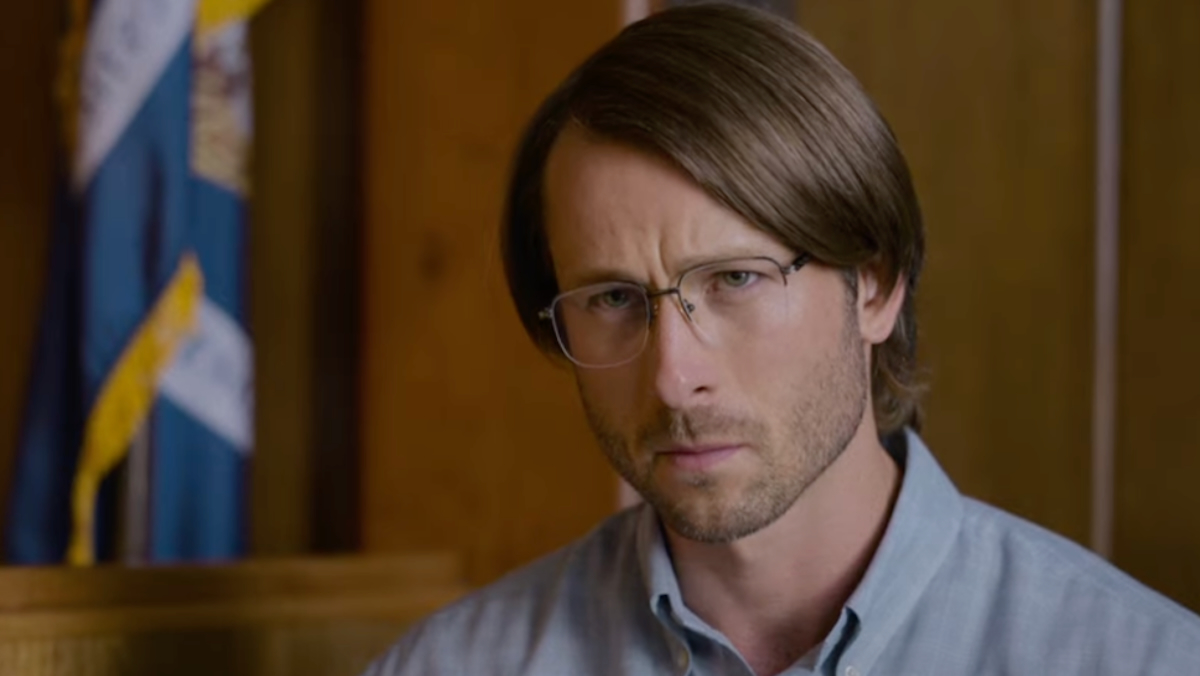
This article contains multitudes of Hit Man spoilers.
The words “true story” are always a curious thing to see at the beginning of a film. Sometimes the term is applied to sober-eyed dramas that seek to convince you they’re nearly documentaries. Think of your Spotlights and All the President’s Mens. More often than not though, the phrase is used as a marketing gimmick for stories where the word “truth” is an abstraction. Think Tobe Hooper’s Texas Chainsaw Massacre.
Which is what makes another Texan director’s latest indie effort, the beguiling Hit Man now on Netflix, so amusingly slippery. Richard Linklater and Glen Powell’s comedy is indeed based on a “true story,” as they promise at the start. And during the end credits, the film has the photographs to prove it: Gary Johnson was a real man who helped assist in the conviction of dozens of citizens charged with soliciting the contracted murder of their friends, family, and neighbors…. but then the Hit Man closing credits also tack on “he didn’t kill anyone (as far as we know!). We made that part up.”
… So really how much of this movie is true and how much of it is entrapping you in a beautiful lie about the nicest fake killer you ever met? Well…
The Real Gary Johnson
Unlike some films with a “true story” title card, Hit Man really does have a foot (or maybe it’s a couple of toes) in reality. Linklater and Powell were inspired to write the film on spec during the pandemic after reading “Hit Man,” Skip Hollandsworth’s long and fascinating profile of the real Johnson. Published in the October 2001 issue of Texas Monthly and running at 7,300 words, Hollandsworth’s piece begins with a pseudo-mystery about how a mild-mannered and fastidious neighbor who reads Shakespeare and the writings of Carl Jung in his free time is secretly also answering cryptic phone calls from strangers ordering up a case of murder.
Of course he never actually kills anyone. But at the age of 54 when the article was published, there’s no denying the real Johnson still managed to carve out a strange niche for himself. For viewers of the movie, it also becomes clear that Johnson never had the inner-self transformation experienced by the character in Linklater’s film. Described frequently as a loner and a man who keeps to himself, Johnson lived with two cats named Id and Ego (but never any dogs) when the article was published and had been doing his faux-hitman thing for well over a decade.
Perhaps the real Johnson would have liked something closer to the life of Powell’s character at the beginning of the film too. After all, the movie’s Gary is introduced as working full time as a professor of psychology at the University of Louisiana. We’re also told he only began working for the local police department to make ends meet and maybe add some spice to his life. By contrast, the real Johnson worked full-time at the district attorney’s office in Houston, Texas (so not New Orleans), with his duties including both technical tasks with audio and visual equipment as well as pretending to be a hitman whenever the DA asked. It was the dedication he took to the assignment though which caused colleagues to liken him to a regular Laurence Olivier.
While he received a master’s degree in psychology from McNeese State University in Lake Charles, Louisiana, and hoped to enter the doctoral program at the University of Houston, he was ultimately not accepted and wound up taking a job as an investigator in the DA’s office. This worked out because even prior to going to college, Johnson had worked as a military policeman during his service in the Vietnam War and then in a Louisiana parish’s sheriff’s department upon returning to civilian life.
The real Johnson eventually was able to get the chance to teach courses in general psychology, as well as human sexuality, at a local community college, but it was only ever as a part-time gig two nights a week. For the rest of his time, he was whatever hitman you needed him to be, and between the late 1980s and 2001 alone, he investigated over 300 reports about someone allegedly seeking a contract killer. Johnson’s efforts led to more than 60 arrests.
The Real Madison Masters
Given so much of the enjoyment in Netflix’s Hit Man stems from the steamy chemistry between Powell’s Gary and Adria Arjona’s “Maddie” Masters, it’s understandable if viewers might hope these two crazy kids were based on exactly such a meet-cute as seen in the film… even if they never killed a crooked cop like Jasper (Austin Amelio) or anyone else. Unfortunately, it never happened like that. Probably.
While the real Johnson, who died in 2022 shortly before the film went into production, was described as having an aura that drew women to him, he apparently struggled to ever maintain a long-term relationship. He was married three times and divorced just as many. In the Texas Monthly article, his second wife Sunny is quoted as saying, “The true essence of Gary is that he is a loner. He’ll show up at parties and have a good time, and he’s always friendly, but he likes being alone, being quiet. It’s still amazing to me that he can turn on this other personality that makes people think he is a vicious killer.”
With that said, the actual meet-cute between Gary and Maddy we see in the film is not entirely invented out of thin air. For starters, the real-Johnson did use a code involving pastry desserts between potential clients and himself. When one interested party met Johnson at a Denny’s, the supposed hitman suggested they trade the lines “that looks like good pie” and “all pie is good pie” as a signal. While this was apparently not something Johnson regularly used, he did have enough “contract” meetings at the local Denny’s for his DA to suggest they name a plate after him.
Furthermore, one meeting did involve a young frightened woman whom Johnson decided to help instead of see arrested. Near the end of Hollandsworth’s long-read, Johnson revealed he did research on a woman so desperate for help in escaping her abusive boyfriend that she asked a Starbucks employee if they knew a hit man. After personally meeting her, Johnson offered a helping hand and referred her to social service agencies and a therapist, hoping she would get herself to a women’s shelter instead of the Houston underworld.
When his profiler teased he was getting soft, Johnson replied, “Just this once. Just this once.”
This ending of the article is the kernel of the idea that led to Hit Man’s playful love story. However, the way that Linklater talks about it, he seems to muse that their film is a fantasy extrapolation of what could have come next. While Linklater met Johnson a few times, he still pointed to the article when he talked about the romantic through-line of the film with Comicbook.com.
“What I knew of him personally, and we gather from his life and everything, he had that view,” Linklater said. “But I think he’d be bemused by this movie. Where we took it is far beyond his own life. I mean, the article about him ends when he lets her off. So everything from then on is this little thrill ride we take you on.”
Fantasy vs. Reality
The thematic text and undergirding of Hit Man—his self-realization into a different man and his finding passion and love with a woman just as flexible in her morality—is largely Linklater and Powell’s invention. However, the real Johnson really did become various district attorneys’ secret weapon for sting operations in Houston and beyond.
He famously got the former vice president for Houstonaires Republican Women, as well as the wealthy wife to an heir to an oil fortune, arrested for soliciting the attempted murder of her husband. He met husbands who wanted to kill wives, wives who wanted to kill husbands, business partners who wanted a permanent dissolution of assets, and even children who wanted him to kill other kids. One youth gave him seven video games and $2.30 to murder a classmate he viewed as a rival for a girl’s affection.
So Johnson’s ability to become whatever hitman his prospective client wanted—whether as a posh businessman who charged six-figure fees or as a blue collar biker who’d do the deed for a free speedboat—all came from Johnson’s real exploits. Albeit his actual collection of characters seemed limited to more a handful of hats as opposed to riffs on numerous pop culture characters like Patrick Bateman.
Nonetheless, Johnson had a storied career that left him with a possibly grimmer outlook on humanity. At the end of the article, Hollandsworth attested he caught the real Johnson looking around his favorite Mexican restaurant, sizing up who might be his next client who wants to facilitate a fatality.
At another point in the article, Johnson is quoted: “Except for one or two instances, the people I meet are not ex-cons. If ex-cons want somebody dead, they know what to do. My people have spent their lives living within the law. A lot of them have never even gotten a traffic ticket. Yet they have developed such a frustration with their place in the world that they think they have no other option but to eliminate whoever is causing their frustration. They are all looking for the quick fix, which has become the American way. Today people can pay to get their televisions fixed and their garbage picked up, so why can’t they pay me, a hit man, to fix their lives?”
Hit Man is streaming on Netflix now.
The post Hit Man and the True Story of Gary Johnson in the Netflix Film appeared first on Den of Geek.





